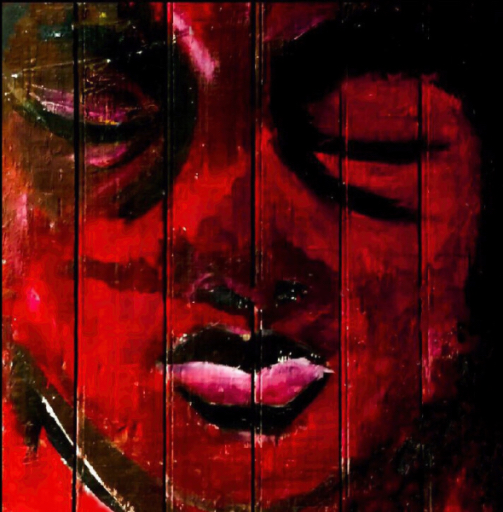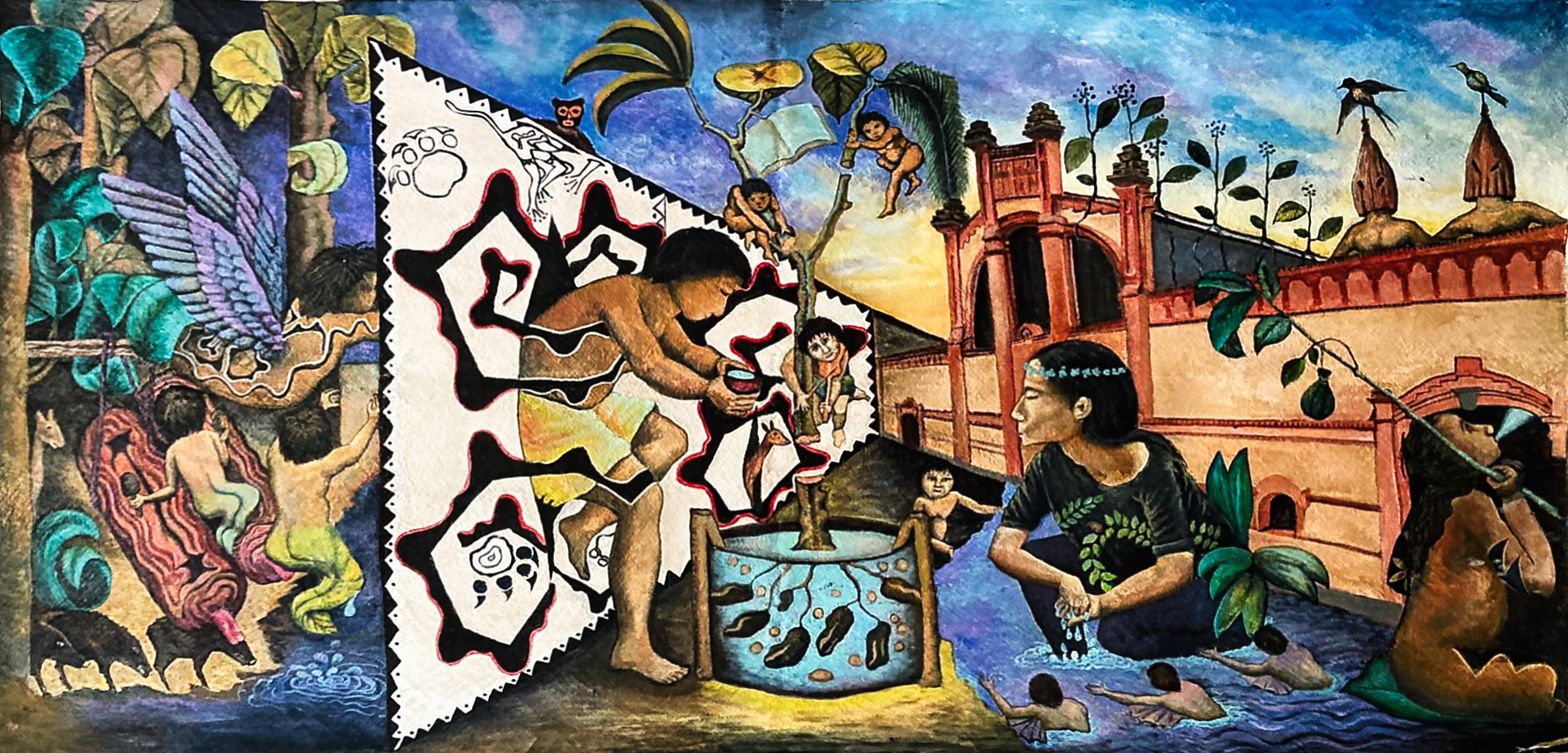
Brus Rubios’ “Entre mundos” (Between Worlds) addresses the transition between tradition and modernity, nature and city, spirituality and matter.
Contemporary Indigenous Art of the Amazon
Transformation, Current Relevance, and Cultural Resilience
Part II: Amazonian Eyes — Pictures of an Inner Vision
What does it mean to see through the eyes of a memory older than oneself?
Contemporary Indigenous art is not merely a representation of myths, but the expression of living visions. These visions arise from a profound understanding of the interconnection between human beings, nature, cosmos, and spirit – between past and present.
They reveal an inner reality that lies hidden beyond the visible world.
Here, it is not the individual “I” that speaks, but the memory of a people – the voice of the ancestors, the gaze of the forest.
What has happened so far:
Long before the first contact with the outside world, magnificent civilizations flourished along the Amazon for countless generations. It was home to a great diversity of peoples, distinguished by their deep knowledge of their environment, a strong sense of community, and a rich culture. Their way of life unfolded in close harmony with nature and was carried by a profound bond with the cosmos.
Legacy in the Deep Forest
Yet this time of flourishing was brutally interrupted by contact with the outside world. A wave of suffering and destruction descended upon them, causing entire communities to collapse and bringing the Indigenous peoples to the brink of extinction. And yet, their legacy endured – in the memory of the peoples, preserved in the shelter of the deep forest.
Today, Indigenous art reflects all of these experiences. Behind it lies far more than aesthetics – it carries the memory of a life in harmony with nature. It reveals the experience of loss and resilience, as well as the vitality of a culture that, despite its wounds, has blossomed anew and continues to thrive in spiritual knowledge.
Let us now turn to the silence – and to what emerges from it.
From there, the distant echoes of ceremonies and rituals reach us, softly resonating in the forest. Within them, ancestral wisdom, inherited traditions, and the artist’s creativity merge into an expressive visual language. It is not merely a preserved memory, but a living voice that binds past and present, silence and vision.
Like a bridge into a world imbued with mysticism, it teaches us to sense the infinity of the cosmos, to recognize the profound value of life, and to understand our inseparable bond with nature.
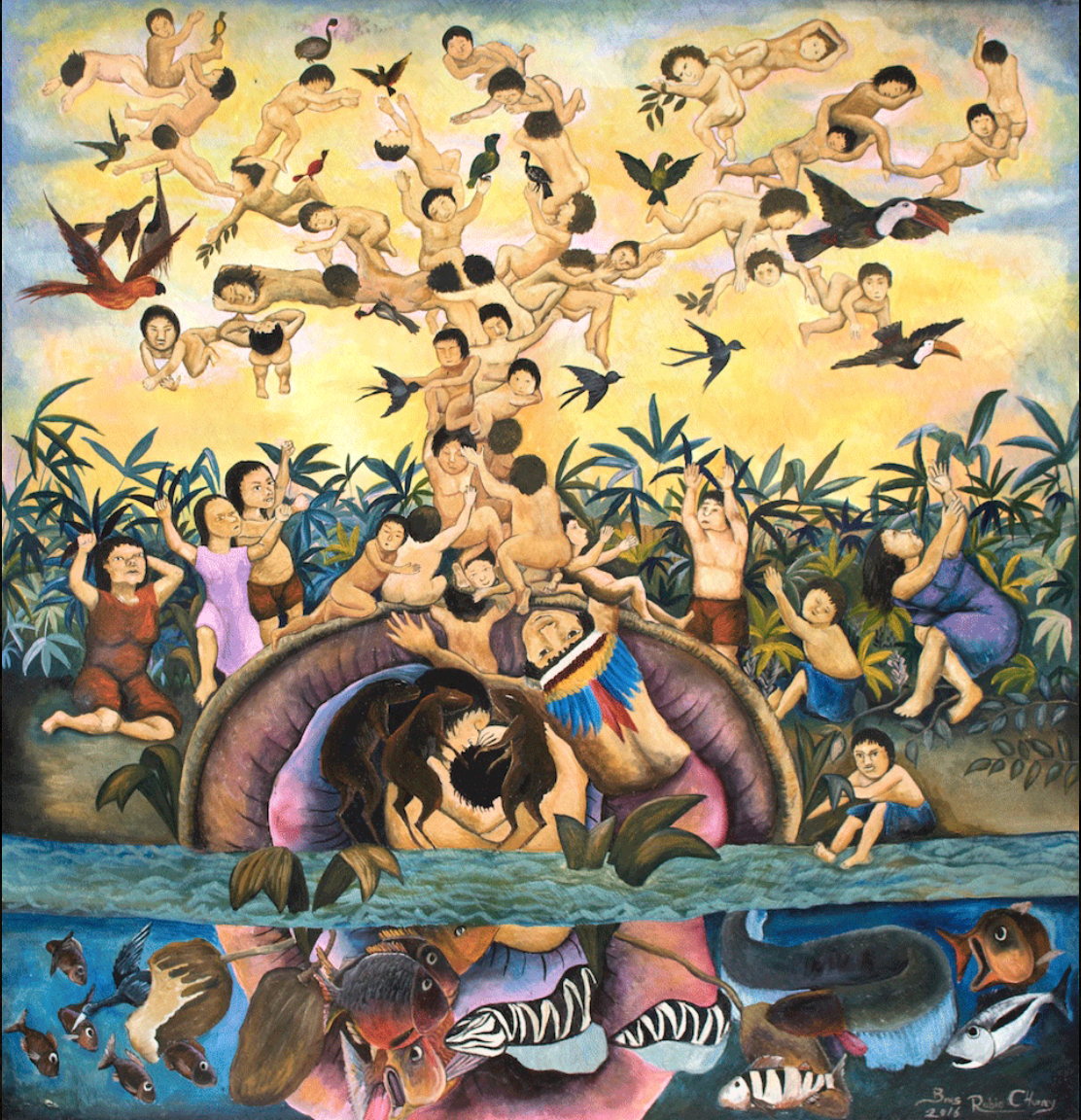
Brus Rubio, Árbol de la Abundancia. In this vision, abundance takes the form of children and birds springing forth from the great anaconda, the ancestral mother. Rubio depicts myth and memory to celebrate life, fertility, and the inexhaustible vitality of the Amazon.
Voices Emerging from Silence
Contemporary Indigenous art explores themes deeply connected to collective memory.
They convey, for instance, ancestral stories and shared narratives that shape identity. At the same time, they express each artist’s unique voice, including their personal history, experiences, and worldview.
This dialogue between the collective and the individual reflects a constant confrontation with the wounds of the past and present. This is particularly evident in cultural displacement, social exclusion, and the systematic silencing of their voices.
In this context, art becomes resistance and recovery. Furthermore, it’s an act of reclamation and a refusal of marginalization. It’s also an affirmation of the right to respect, recognition, and belonging.
These works don’t just speak of loss. On the contrary, they are also a pursuit of healing and re-forging.
Thus, contemporary Indigenous art becomes a space for critique and reflection — a gathering of voices that question dominant narratives and carve new paths toward cultural affirmation.
From Echo to Creation — Timeless Testimonies
Some artists have placed this confrontation in stark, lived reality—murals appear in communities devastated by oil spills, portraits memorialize leaders slain for defending their lands, and pictorial series denounce contamination of sacred rivers. These works are not merely narratives; they become living documents, preserving memory and giving form to struggles.
This artistic activism fosters intercultural dialogue, awakens global awareness of the socio-environmental crisis in the Amazon, and channels solidarity with Indigenous struggles. By carrying these realities beyond local boundaries, art becomes a conduit for visibility and participation—and amplifies voices historically marginalized from decision-making.
For viewers, these works cannot be approached as distant observations: they are invitations to bear witness to a history still in the making—one that demands to be told with the same urgency with which it is painted. In this way, contemporary Indigenous art creates a space for critique and reflection.
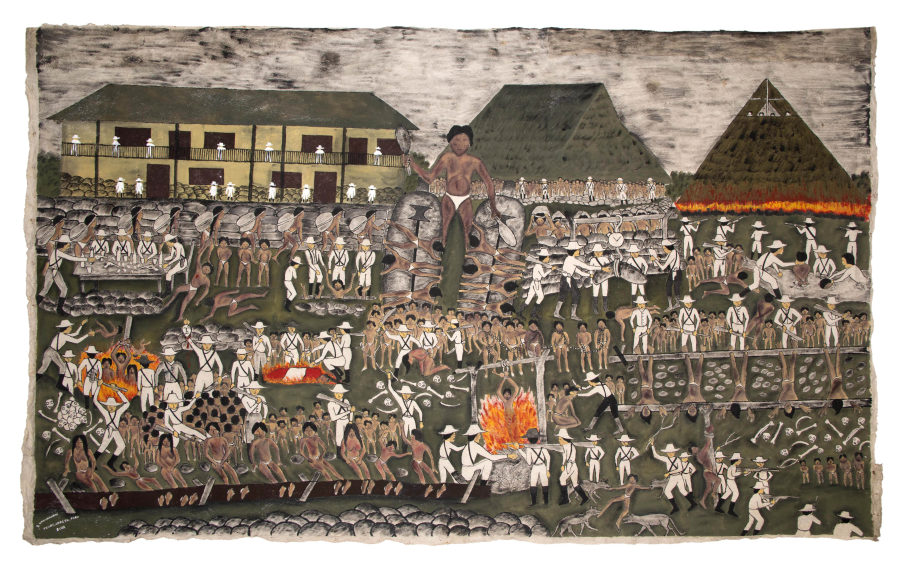
Santiago Yahuarcani, El corazón de los barones del caucho, is a searing testimony of the Amazon’s rubber era. A memory of pain and resistance, both accusation and remembrance, painted so that the silenced voices may still be heard.
Voices Whispering Memories, Healing Wounds,
and Breaking the Silence
Indigenous artists themselves don’t always agree on the primary message of their art. Rather, it comes across as a complex chorus—diverse expressions that powerfully reveal what moves the Amazon’s Indigenous peoples: loss of land, culture, spirituality, ancestral wisdom, and identity.
What stands out in any given work changes with the viewer and the moment, reflecting a spectrum of nuances and perspectives. That very variety—and the absence of a single, unified voice—is precisely the strength of this art. These fractures don’t weaken; they enrich the Indigenous cultural experience.
Contemporary Indigenous art isn’t a single message or a polished narrative. It is wound and healing; loss transformed into re‑appropriation; memory reinventing itself. It is both spiritual and political, weaving the personal with the collective. This rich tapestry of perspectives and internal tension makes contemporary Indigenous art deeply powerful, genuine, and relevant.

Rember Yahuarcani, A spirit in motion, carrying rivers, memories, and ancestral voices within the living flow of the Amazon, Contemporary Indigenous Art.
The Future of Contemporary Indigenous Art: Challenges and New Voices
For a long time, Indigenous art was ignored, misread, or dismissed. It lived in a world that did not yet know how to listen, often reduced to a folkloric curiosity instead of being recognized as contemporary art. Yet art persists: it speaks, even when unheard. Today, by contrast, it captures global attention and moves audiences with its depth and powerful visual language.
Territorial dispossession, environmental destruction, and cultural marginalization still threaten Indigenous communities—endangering not only their lands and waters, but also cultural continuity and the spiritual ground from which their art arises.
And yet, these very pressures often become a source of artistic force. Indigenous voices carry beyond borders and institutions, reshaping what contemporary art can be. This art doesn’t ask for validation; it offers revelation.
An Amazonian voice for the world
Indigenous artists aren’t subjects in a study, they’re active agents shaping the global art landscape, speaking from lived experience and claiming recognition on their own terms.
Despite enduring challenges, contemporary Amazonian art is increasingly seen as a distinct and vital form of contemporary art, powerful, passionate, and ever‑evolving.
Perhaps our role now is not to speak for these voices, but to listen. To honor not just their cultural depth, but the ethical urgency they carry. To understand the Amazon not merely as a place, but as a way of seeing, knowing, and being in the world.
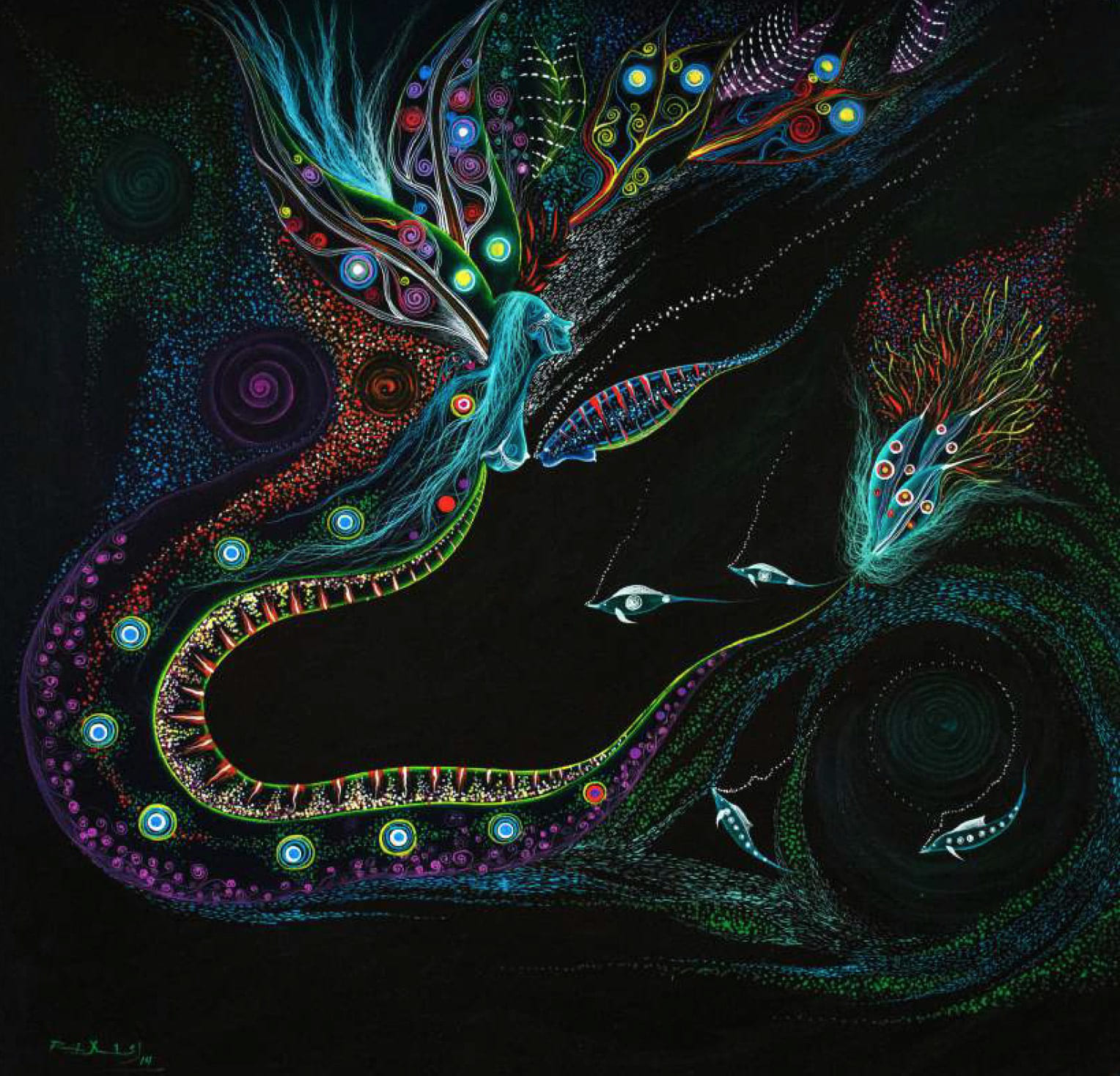
Rember Yahuarcani, La Lluvia dentro del Río, In this vision, the river becomes a living space where spiritual beings emerge—protectors, guides, and memories flowing with the water. Yahuarcani evokes the ancestral understanding of rivers as sacred beings, carriers of life and spirit.
Art that Transforms Perception
This art invites us to see the world through profoundly different eyes. The millennia-old wisdom of Amazonian peoples shows us that humans are not separate from nature but an intrinsic part of it. Their worldview isn’t built on mastery or dominion; it’s rooted in reciprocity and kinship with the living world.
For centuries, Amazonian communities have lived in mutual balance with their environment—honoring and protecting it. Their traditional agroforestry and intercropping practices, which combined trees, crops, and edible forest species, reshaped ecosystems and enriched biodiversity over thousands of years, illustrating that sustainable land stewardship was the norm rather than the exception.
Today, this worldview offers inspiration for more sustainable ways of life—and urges us to rethink our relationship with nature entirely. As global awareness of the Amazon’s ecological and cultural importance grows, so does interest in its artistic expressions. New generations of Indigenous artists inherit techniques and stories—but more than anything, they reinvent their visual languages, expanding ancestral forms in innovative ways.
Vision in Evolution
For many Indigenous artists, social media has become a surprising platform—not just for sharing their work, but for building community, discovering peers, and reaching people who might never step into a gallery. Others bring their art into global biennials, art fairs, and dynamic urban art spaces—crafting bridges between the local and the global.
In these platforms, the fight for territory and cultural survival merges with aesthetic experimentation. We see immersive installations, collective murals, video art, and documentary photography. Climate disruption, rampant deforestation, and biodiversity loss aren’t just themes—they spark new visual metaphors, reshaping how we imagine living on this planet.
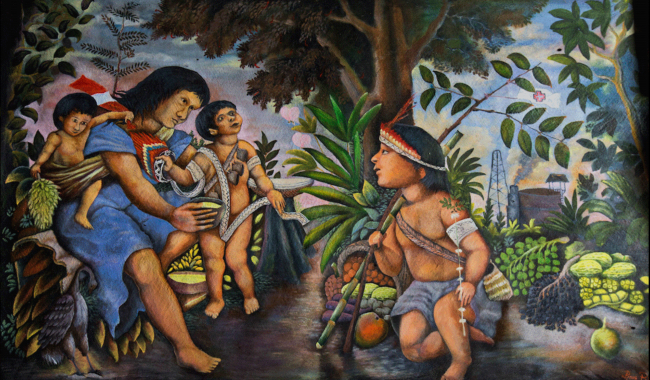
In “The Heir,” Brus Rubio depicts a young Indigenous person at the crossroads between tradition and progress, inheriting both ancestral wisdom and a world threatened by advancing industry.
Indigenous Creativity in the Digital Era
Indigenous art carries a philosophy that challenges Western frameworks. It teaches us that nature is not a resource but a living being—a relative imbued with spirit and rights.
In a forward-looking society, recognizing these worldviews isn’t about nostalgia. It’s about embracing real progress rooted in sustainability, reciprocity, and balance with life. Faced with the crises of climate and existence, these perspectives are not “alternative”—they’re essential.
Looking ahead, we see a growing flourishing of both Indigenous and non-Indigenous voices. Each one, in its own way, adds richness to a deepening, evolving narrative. This isn’t a past frozen in ceremony—it’s a vision that is deeply ancestral and vividly modern.
And so, this vision points us toward a future where ancient wisdom and modern urgency meet, where the world is not just seen—but known, felt, and lived anew.
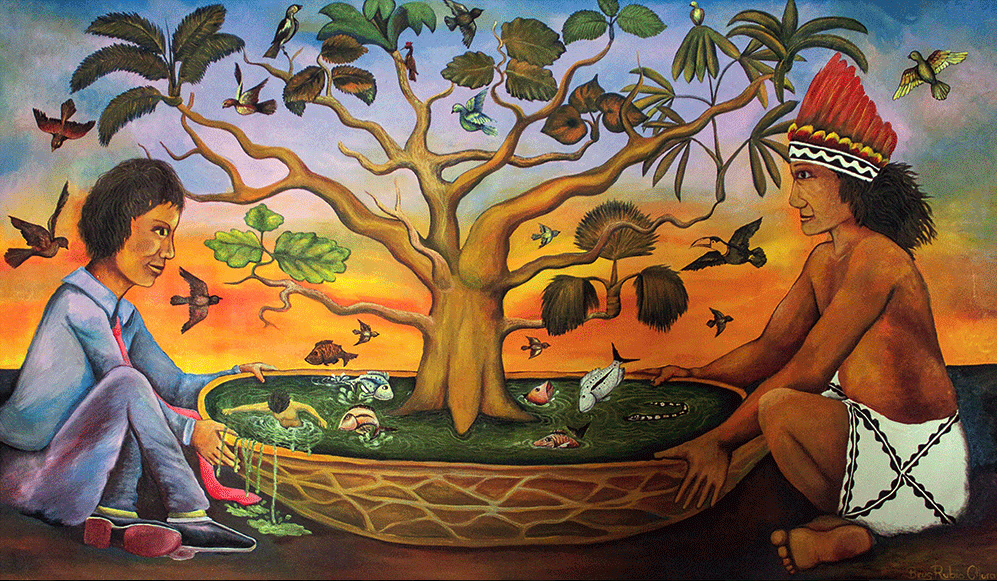
Brus Rubio, The Macambo Plate, A vision where tradition and modernity dialogue in the face of present urgencies.
Art beyond Words
Art doesn’t explain the world — it transforms the way we see it. It safeguards memory, culture, and tradition, while also reflecting the present. It guides us to a place where knowledge, wisdom, and emotion are not only expressed but where a deeper connection becomes tangible.
Whether ritual or personal, spiritual or communal, here we meet stories that are not simply told but lived. The force of contemporary Indigenous art often reaches us where words can go no further.
It becomes an invisible thread linking humans, animals, plants, and spirits — a bridge between worlds. This thread is unseen yet tangible: a web of experiences, myths, and dreams stretching beyond what the eye perceives.
It bridges the visible and the invisible, the past and the present, collective memory and the individual soul. It opens spaces where the rational meets the spiritual, where the material and the transcendent come together.
Indígenous art doesn’t just depict a world, it transforms origin, history, spirituality, identity, and worldview into forms we can experience.
By rendering them visible, it invites us closer to their hidden depth.
Epilogue: The Echo of Voices
In a world that often silences them, contemporary Indigenous art rises as a profound echo, breaking through walls of loss and invisibility.
It stands as an act of resistance — proof that memory, identity, and spirit do not fade but are reborn through the artist’s gaze.
This layered narrative, rich in contrast and nuance, invites us to listen beyond words and to see beyond images.
Within this diversity lies the true strength of a people who do not let their culture fade, a people who carry their history forward through art
An open story — a possible future
This article corresponds to Part II of a two-part essay. You can find Part I here:
